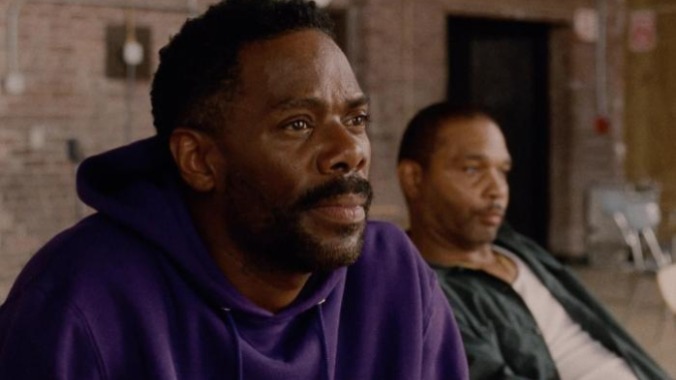Sensitive Prison Drama Sing Sing Finds Collective Healing in Theater

30 miles north of New York City, situated directly on the bank of the Hudson River, lies Sing Sing, a maximum security prison that has been operational for nearly 200 years. For much of its lifespan, the institution has been known for its harsh conditions—it was the site of frequent electric chair executions until New York abolished the death penalty and is known for treating those imprisoned there with a severe sense of discipline and regulations. But by the late ‘90s, it had also become the founding location of the Rehabilitation Through the Arts (RTA) program, which brings in theater creatives to work with the incarcerated population on developing and performing their own plays, offering a sense of community and camaraderie which has proven to have positive effects on the men. The program now exists at five other New York prisons.
Greg Kwedar’s sensitive, joyous Sing Sing does more than simply dramatize the workings of the RTA program, it incorporates participants into the very fabric of the film’s DNA. Most of the cast is composed of former New York prisoners who had gotten involved in RTA during their incarceration, turning the film’s depiction of a prison theater production into a reflection of honest, shared experiences by the performers. But, while much of Sing Sing’s success is owed to the moving nature of these men’s reality, they are not used as props. Sing Sing is an emotional prison drama that doesn’t beg for your tears amid all of the typical heartstring-tugging signifiers that come with the genre’s territory. It represents these lives sincerely and avoids grandiose histrionics, melding the real experiences of these men within the fantasy of filmmaking to find graceful emotional truths.
The element of unreality comes in the form of Sing Sing’s lead performer: Colman Domingo portrays an interpretation of the real-life John “Divine G” Whitfield, a long-time participant in RTA who now helps lead the program, alongside being a hobbyist playwright when he’s not working on how he’ll convince the review board that he deserves parole for the crime that he was wrongly imprisoned for. We meet him on stage delivering a climactic moment in A Midsummer Night’s Dream, the culmination of what was surely weeks of rehearsal. But the members of RTA don’t rest, and the crew immediately convenes to decide their next project.
They’ve also just introduced a new face into the mix: Clarence “Divine Eye” Maclin (Maclin plays himself; he and the real Whitfield have story credits on the film), a hardened prisoner that we first meet threatening someone in the prison yard over money missing from a drug deal. But Divine G sees something more in him. Divine Eye is brought into the new brainstorming session, where he derails the idea of doing Divine G’s own drama The Fine Print, and instead suggests they go for comedy since life in prison is hard enough as is. This prompts everyone to start throwing ideas out and the final, original script assembled by the project’s director Brent Buell (Paul Raci) ends up a 140-plus-page concoction of wildly disparate ideas and characters amalgamated together: Hamlet, Egyptian princes, pirates, cowboys, Freddy Krueger, and time vortexes are all integral to the story. The men get to work immediately.
This was a real play written by the actual Brent Buell, called Breakin’ the Mummy’s Code, as documented in John H. Richardson’s Esquire article “The Sing Sing Follies,” which inspired this film. The heart of Sing Sing lives and breathes in the world of theater, but more broadly acts as a statement regarding the importance and universality of artistic creation. Much of the story’s first half takes on a lighthearted tone and is frequently very funny, but without disruptively ramming jokes in to try and get a laugh—these guys are just funny, and their work in RTA is portrayed as a blissful source of light and creativity within a system built to otherwise control and dehumanize them. Sing Sing recognizes the inherent humor in watching a group of stereotypically intimidating maximum-security prisoners embracing the vulnerability and potential embarrassment of auditioning, getting loose with vocal and physical warm-ups, and donning silly costumes to inhabit a made-up world. It also treats their work seriously and celebrates their commitment to doing it right. It helps that the majority of the troupe has been in RTA for a long time by the start of the movie, and already knows the power of that escape—they’ve formed a family.
-

-

-

-

-

-

-

-

-

-

-

-

-

-

-

-

-

-

-

-

-

-

-

-

-

-

-

-

-

-

-

-

-

-

-

-

-

-

-

-








































